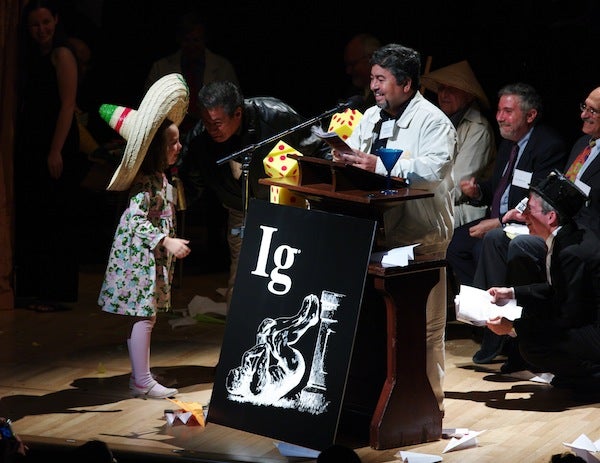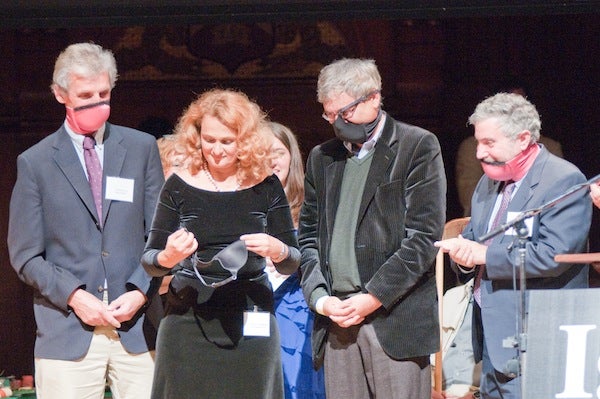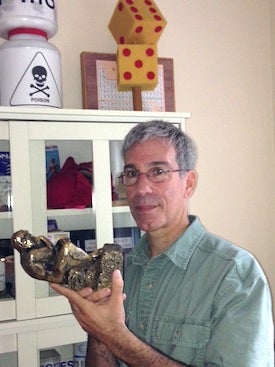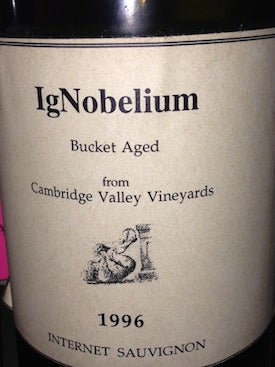This article was published in Scientific American’s former blog network and reflects the views of the author, not necessarily those of Scientific American
CAMBRIDGE, MA. — An ancient black morning coat and ragged chapeau claque (a collapsible mechanical top hat) hang on a door hook. A faux bronze version of Rodin’s classic statue The Thinker lies on a nearby windowsill. Toppled backwards off his pedestal, he’s known as The Stinker. A curio cabinet contains oddities like DNA cologne from Bijan of Beverly Hills, cheap Mexican tequila used to make diamonds, tin cans with strings attached to a funky blue cell phone, and an old hand mirror, emblazoned with the motto, “May the Light of Truth and Knowledge Shine.”
The hand mirror was the official prize for the 1st Annual Ig Nobel Awards in 1991; it contained an audio chip that screamed when winners picked it up. A quarter-century later, the awards’ irreverent impresario, Marc Abrahams, will once again take his formal coat and hat off the hook in his memorabilia-filled home office to host the 25th Annual Ig Nobel Awards ceremony tonight in Harvard University’s august Sanders Theater.
The 2015 Ig Nobel Prize winners:
CHEMISTRY PRIZE — For inventing a chemical recipe to partially un-boil an egg.
Callum Ormonde and Colin Raston [Australia], and Tom Yuan, Stephan Kudlacek, Sameeran Kunche, Joshua N. Smith, William A. Brown, Kaitlin Pugliese, Tivoli Olsen, Mariam Iftikhar, Gregory Weiss [USA]
PHYSICS PRIZE — For testing the biological principle that nearly all mammals empty their bladders in about 21 seconds (plus or minus 13 seconds).
Patricia Yang [USA and Taiwan], David Hu [USA and Taiwan], and Jonathan Pham, Jerome Choo [USA]
LITERATURE PRIZE — For discovering that the word "huh?" (or its equivalent) seems to exist in every human language — and for not being quite sure why.
Mark Dingemanse [The Netherlands, USA], Francisco Torreira [The Netherlands, Belgium, USA], and Nick J. Enfield [Australia, The Netherlands]
MANAGEMENT PRIZE — For discovering that many business leaders developed in childhood a fondness for risk-taking, when they experienced natural disasters (such as earthquakes, volcanic eruptions, tsunamis, and wildfires) that — for them — had no dire personal consequences.
Gennaro Bernile [Italy, Singapore, USA], Vineet Bhagwat [USA], and P. Raghavendra Rau [U.K., India, France, Luxembourg, Germany, Japan]
ECONOMICS PRIZE — The Bangkok Metropolitan Police [Thailand], for offering to pay policemen extra cash if the policemen refuse to take bribes.
MEDICINE PRIZE — For experiments to study the biomedical benefits or biomedical consequences of intense kissing (and other intimate, interpersonal activities).
Awarded jointly to two groups: Hajime Kimata [Japan, China]; and to Jaroslava Durdiaková [Slovakia, USA, U.K.], Peter Celec [Slovakia, Germany], Natália Kamodyová, Tatiana Sedláčková, Gabriela Repiská, Barbara Sviežená, and Gabriel Minárik [Slovakia]
MATHEMATICS PRIZE — For trying to use mathematical techniques to determine whether and how Moulay Ismael the Bloodthirsty, the Sharifian Emperor of Morocco, managed, during the years from 1697 through 1727, to father 888 children.
Elisabeth Oberzaucher [Austria, Germany, U.K.] and Karl Grammer [Austra, Germany]
BIOLOGY PRIZE — For observing that when you attach a weighted stick to the rear end of a chicken, the chicken then walks in a manner similar to that in which dinosaurs are thought to have walked.
Bruno Grossi, Omar Larach, Mauricio Canals, Rodrigo A. Vásquez [Chile], José Iriarte-Díaz [Chile, USA]
DIAGNOSTIC MEDICINE PRIZE — For determining that acute appendicitis can be accurately diagnosed by the amount of pain evident when the patient is driven over speed bumps.
Diallah Karim [CANADA, U.K.], Anthony Harnden [New Zealand, U.K., USA], Nigel D’Souza [Bahrain, Belgium, Dubai, India, South Africa, USA, U.K.], Andrew Huang [China, U.K.], Abdel Kader Allouni [Syria, U.K.], Helen Ashdown [U.K.], Richard J. Stevens [U.K.], and Simon Kreckler [U.K.]
PHYSIOLOGY and ENTOMOLOGY PRIZE — For carefully arranging for honey bees to sting him repeatedly on 25 different locations on his body, to learn which locations are the least painful (the skull, middle toe tip, and upper arm). and which are the most painful (the nostril, upper lip, and penis shaft).
Awarded jointly to two individuals: Justin Schmidt [USA, Canada], for painstakingly creating the Schmidt Sting Pain Index, which rates the relative pain people feel when stung by various insects; and to Michael L. Smith [USA, U.K., The Netherlands]
FULL LIST with Scientific References can be found at Ig Nobel website, www.improbable.com.
On supporting science journalism
If you're enjoying this article, consider supporting our award-winning journalism by subscribing. By purchasing a subscription you are helping to ensure the future of impactful stories about the discoveries and ideas shaping our world today.
Here's a promo created for the 2015 ceremony:
This sold-out, wacky fall ritual affectionately pokes fun at science and technology, with the underlying goal to honor accomplishments that “first make people laugh, and then make them think,” says Abrahams, who founded the prizes. The eclectic global audience of bemused scientists, techies, students, journalists and members of the general public goes far beyond the packed 1,100-seat auditorium here.
They follow from afar—by live webcast and the Twitter hashtag #IgNobel—to find out the top 10 annual prize winners in an array of sciences, from psychology to physics, as well as technology, art, literature and even an Ig Nobel Peace Prize. Genuine Nobel Prize-winning scientists hand out the awards, which over the years have unearthed obscure research that answers age-old questions you may (or may not) have thought about and inventions that solve problems you may (or may not) be worrying about. A small sample:
Q. How can women’s underwear do double duty? A. “A Brassiere that, in an emergency can be quickly converted into a pair of protective face masks” (Public Health Prize 2009).
Q. How does cereal get soggy—so quickly? A. “A Study of the Effects of Water Content on the Compaction Behaviour of Breakfast Cereal Flakes” (Physics 1995).
Q. How can careless men in tight pants get help? A. “Acute management of the Zipper-Entrapped Penis” (Medicine 1993).
Q. How smart are pigeons, really? A. “Pigeons’ Discrimination of Paintings by Monet and Picasso” (Psychology 1995).
There is actual scientific research, much of it published, behind each silly-sounding award and a method behind the madness, says the youthful 59-year-old Abrahams, whose 1991 mop of brown hair has turned grey with the years though his enthusiasm remains undiminished. He sees the Ig Nobels, as well as his science humor magazine, Annals of Improbable Research (AIR), a blog and now a weekly podcast, as a way to engage those already interested in science and those who feel intimidated by it.

Miss Sweetie Poo, the ceremony's timekeeper, and 2009 Chemistry Award winners Javier Morales (standing at podium) and Miquel Apátiga (leaning), co-discoverers of a way to convert tequila into diamonds. (Credit: Eric Workman / Improbable Research)

2009 Ig Nobel Prize winner Dr. Elena Bodnar demonstrates her invention, a brassiere that can quickly convert into a pair of protective face masks, assisted from left to right by Nobel laureates Wolfgang Ketterle, Orhan PamU.K. and Paul Krugman. (Credit: Alexey Eliseev/Improbable Research)
“I have always been interested in things that are funny in a way that makes you pay attention to them and keep paying attention. Take the study of the homosexual necrophiliac duck for example. It is so far outside anyone’s experience that it’s funny. The only healthy reaction is to laugh at it, and in the moment of paying attention you might get interested,” says Abrahams.
There are now about 9,000 nominations a year that are pared down to the top 10 winners. The lion’s share of the Ig Nobel awards (1991-2014) have gone to American scientists (207), followed by the U.K. (73), Japan (61), Australia (33) and France (22), according to Silk, an interactive database that analyzed the awards (multiple recipients per award adds up to far more than the 240 Ig Nobels to date). A map of winners, however, shows small groups scattered around the world.
While the topics are diverse, there is a clear predilection for “below the belt” sex and bathroom research: a feasibility study of “Magnetic Resonance Imaging of Male and Female Genitals and Female Sexual Arousal,” a comprehensive world review of case reports of “Rectal Foreign Bodies,” and “Farting as a Defense against Unspeakable Dread.”

Ig Nobel founder Marc Abrahams holding The Stinker. (Credit: Cristine Russell)
Some Ig Nobels have chastised individual targets for their less than noble actions. In 1991, then Vice President Dan Quayle got the Education Prize “for demonstrating better than anyone else the need for science education” and Wall Street junk bond king Michael Milken, then in jail, won the Economics Prize. In 2000, the Reverend Sun Myung Moon received the Economics Prize “for bringing efficiency and steady growth to the mass-marriage industry.” And in 2010, the award went back to Wall Street executives and directors of firms like Goldman Sachs, AIG, Lehman Brothers and Bear Sterns “for creating and promoting new ways to invest money.”
The Ig Nobels “have always been very popular among readers. To be honest, they have often been even more popular than the other, more serious stuff I have written,” veteran Swedish journalist Karin Bojs, former science editor of the daily newspaper Dagens Nyheter in Stockholm, wrote in an email. “They can reach teenagers and folks not so much involved in science. But they can also reach a very qualified audience, since they really fulfill their motto to make people ‘laugh, but then think.’”
At the newspaper, Bojs’ had an annual ritual, reporting on the Ig Nobel first as a funny run-up to Sweden’s biggest story, the eagerly anticipated Nobel Prize announcements. The 2015 string of Nobels starts on October 5 with the 2015 Prize in Physiology or Medicine. From the start, Abrahams has sought to distinguish the Ig Nobels from the illustrious Nobels: “The chief rule has been ‘always be very respectful of the Nobels,’Make sure people understand there is no connection. Nobel prizes are important. Ig Nobels are wonderful, but they are not important.”

Ig Nobel wine, one of the many prize-related curiosities found in Marc Abrahams' office. Credit: Cristine Russell
It’s the sense of humor that is important, and from the beginning Abrahams has recruited humor-loving Nobelists as featured participants in the annual Cambridge ceremony. In 2015, Nobel Laureates Carol Greider (Physiology or Medicine, 2009), Jack Szostak (Physiology or medicine, 2009), Eric Maskin (Economics, 2007), Frank Wilczek (Physics, 2004), , and Dudley Herschbach (Chemistry, 1986) are on tap to hand out Ig Nobels. (Herschbach also participated in the 1st ceremony.)
It is a point of pride that one scientist, Andre Geim, won an Ig Nobel in Physics first (in 2000 for levitating a live frog with magnets) and later a Nobel Prize in Physics (in 2010, for experiments with graphene, the thinnest, strongest, most conductive material known). He told the BBC: "Frankly, I value both my Ig Nobel prize and Nobel prize at the same level and for me the Ig Nobel prize was the manifestation that I can take jokes, a little bit of self-deprecation always helps."
“Most scientists have a sense of humor,” says Boston University School of Medicine Professor Deborah Anderson (Ig Nobel in Chemistry 2008, for studying the effectiveness of Coca Cola as a spermicide). The Ig Nobel “opened several doors for me,” including being asked by the British Medical Journal to “write a parody for the special Christmas issue.” Anderson returns to the Ig Nobel stage again this year. “There is such a high level of energy and festivity at the performances, both onstage and off,” she wrote in an email. “Some of my favorite parts are the paper airplane competition at the intermission, and the scientific demonstrations which are often very ambitious and end badly.”
After winning the 2003 Ig Nobel Biology Prize “for documenting the first scientifically recorded case of homosexual necrophilia in the Mallard duck” Kees Moeliker, a curator at the Natural History Museum in Rotterdam, the Netherlands, gained a certain kind of fame. “Thanks to the Ig, my duck paper got more than the seven or eight times the number of readers that ornithological case reports usually get, and my interest in remarkable animal behaviour became widely known,” he wrote in an email. Moeliker wrote a best-selling Dutch book, whose title translates to The Duck Guy, and “with my stuffed duck in my suitcase, I travelled the world lecturing people of all kinds (about) 'how a dead duck changed my life' - and believe me - my life did change!”
Moeliker also became part of the Ig Nobel inner circle, “European bureau chief” for Improbable Research, and an organizer and performer in touring Ig Nobel events. “People (yes, real people) with such bright and open minds are hard to find, and the Ig Nobel Prize brings them together,” he said.